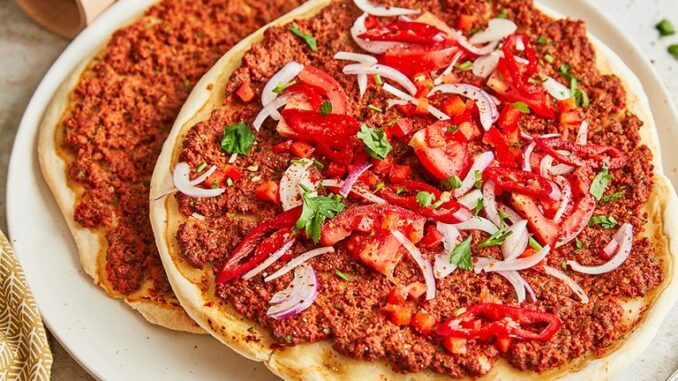
Lahmacun, a cherished staple of Turkish cuisine, embodies the rich culinary heritage of the region with its tantalizing blend of flavors and textures. Often referred to as “Turkish pizza,” this thin, crispy flatbread is adorned with a savory topping of minced meat, vegetables, and aromatic spices, making it a favorite street food and household dish alike. In this comprehensive exploration, we delve into the history, cultural significance, and recipe of lahmacun, inviting you to embark on a flavorful journey through the heart of Turkey.
A Brief History of Lahmacun: The origins of lahmacun can be traced back centuries to the Middle East, where flatbreads have long been a dietary staple. The exact origins of lahmacun are debated, with various regions claiming to be the birthplace of this beloved dish. However, it is widely believed that lahmacun originated in the Levant region, which encompasses present-day Turkey, Syria, Lebanon, and Palestine.
Lahmacun gained popularity across the Ottoman Empire, where it was enjoyed as a street food snack by people from all walks of life. Over time, the recipe evolved to incorporate local ingredients and flavors, resulting in the diverse variations of lahmacun that exist today.
The Cultural Significance of Lahmacun: In Turkish culture, lahmacun holds a special place as a symbol of shared meals, hospitality, and communal dining. Traditionally, lahmacun is prepared in large batches and enjoyed with family and friends during gatherings and celebrations. Its versatility and portability make it a popular choice for picnics, parties, and street food vendors alike.
Beyond its culinary appeal, lahmacun also carries cultural significance as a symbol of cultural exchange and culinary heritage. The dish reflects the diverse influences that have shaped Turkish cuisine over the centuries, blending elements of Middle Eastern, Mediterranean, and Central Asian culinary traditions into a harmonious and flavorful creation.
The Recipe for Lahmacun: Now, let’s delve into the recipe for lahmacun, allowing you to recreate this iconic dish in your own kitchen:
Ingredients:
- For the Dough:
- All-purpose flour
- Yeast
- Warm water
- Olive oil
- Salt
- For the Topping:
- Ground lamb or beef
- Onion
- Tomatoes
- Bell peppers
- Parsley
- Garlic
- Tomato paste
- Paprika
- Cumin
- Red pepper flakes
- Salt and pepper
Instructions:
- Prepare the dough by mixing flour, yeast, warm water, olive oil, and salt in a bowl. Knead the dough until smooth and elastic, then cover and let it rise for about an hour.
- While the dough is rising, prepare the topping. In a food processor, combine ground meat, onion, tomatoes, bell peppers, parsley, garlic, tomato paste, and spices. Pulse until the mixture is finely chopped and well combined.
- Preheat your oven to a high temperature (around 450°F or 230°C).
- Divide the dough into small balls and roll them out into thin circles on a floured surface.
- Spread a thin layer of the meat mixture over each dough circle, leaving a small border around the edges.
- Transfer the lahmacun to a baking sheet lined with parchment paper and bake in the preheated oven for 8-10 minutes, or until the edges are golden brown and crispy.
- Remove from the oven and serve immediately, garnished with fresh parsley, lemon wedges, and your favorite toppings such as lettuce, cucumbers, and onions.
Variations and Tips:
- Experiment with different meat and vegetable combinations for the topping to suit your taste preferences.
- For a vegetarian version, you can omit the meat and add extra vegetables such as mushrooms, eggplant, or zucchini.
- Serve lahmacun with a side of yogurt or tzatziki sauce for added creaminess and flavor.
- Leftover lahmacun can be reheated in the oven or enjoyed cold the next day as a delicious snack or light meal.
Conclusion: Lahmacun, with its crispy crust and flavorful topping, embodies the essence of Turkish cuisine with every bite. Whether enjoyed fresh out of the oven or as a grab-and-go street food snack, lahmacun invites you to experience the rich flavors and cultural heritage of Turkey. By exploring the history, cultural significance, and recipe of lahmacun, you can embark on a culinary journey that celebrates the vibrant traditions and flavors of this beloved dish.